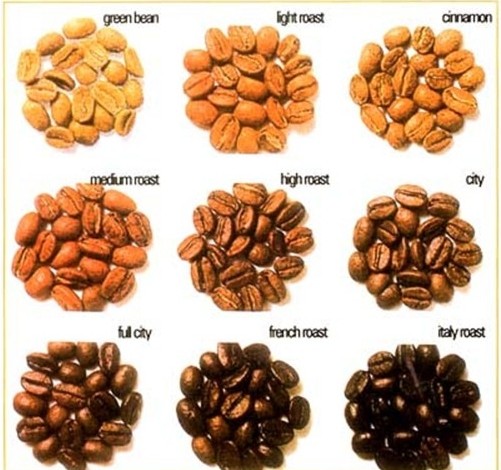A detailed introduction of Italian coffee beans: a brief discussion on the technical skills of blending and baking Italian coffee
A perfect Espresso is affected by many factors, let's talk about blending and baking first.
1. Match:
A perfect Espresso starts with a mix. The perfect Espresso requires sweetness, and the overall taste will be balanced, with a perfect balance of bitterness, acidity, sweetness and finish. This is a task that can not be accomplished by a single coffee bean, so in order to get a perfect Espresso, we must first have a perfect coffee bean matching scheme, which refers not only to the collocation of coffee beans from different places, but also to the coordination between the different roasting degrees of the same kind of coffee beans, whether it is the collocation of coffee beans from different places or the different roasting degrees of coffee beans from the same place. There is only one principle of blending to achieve the final balance of Espresso coffee taste.
2, bake:
Espresso requires a deeper baking degree that is different from other extraction methods. Baking can be divided into light baking, medium baking and deep baking. In addition to this simple classification, there is a more complex classification of SCAA baking, including shallow baking, medium baking, deep baking and re-baking.
The extraction method, such as hand-brewed coffee, which emphasizes the flavor of origin, usually uses medium-to-deep roasting for coffee beans, but for Espresso, non-re-roasting is not enough to reflect the perfection of Espresso taste. The baking degree of most Espresso beans is in the re-baking stage after the peak of the second explosion.
On the one hand, this baking degree is due to the extraction principle of Espresso. The extraction of Espresso is completed in 25 to 30 seconds. In order to completely extract the essence of coffee in such a short time, the caramelization reaction must be carried out more fully from the beginning of baking, the formation of coffee aromatic oil is more thorough, and the coffee aromatic oil can reach the surface of coffee cells as much as possible by means of re-baking. In order to achieve the acquisition of essence in the limited extraction time.
On the other hand, this kind of baking is also related to the birthplace of Espresso. Espresso is a coffee extraction method that originated in Italy. At the end of the 19th century and the beginning of the 20th century, that is, when the Espresso extraction method was born, Italy was not a rich country in Europe. Due to its own economic strength, the popular coffee in Italy was not of high quality, and most of them drank inferior robusta coffee. Robusta coffee contains unpleasant earthy taste and strong astringent taste. in order to cover up this bad taste, the coffee roaster chose the re-baking method to cover up the bad flavor of the coffee at the cost of losing part of the coffee flavor. This tradition continues to this day, and many people insist that authentic espresso should be served with robusta coffee. Even big brands of espresso beans like Lavazza make no secret of their love of robusta coffee, just like ILLY has begun to avoid the experience of using robusta beans in its blending in recent years. Especially at the moment of the rise of the concept of boutique coffee, as a specialty coffee store, we still adhere to the quality assurance of boutique coffee.
Source:
Happy Coffee Xiao Xu's blog
Important Notice :
前街咖啡 FrontStreet Coffee has moved to new addredd:
FrontStreet Coffee Address: 315,Donghua East Road,GuangZhou
Tel:020 38364473
- Prev

Exploring the World's Fine Coffee beans: subverting the other side of your understanding of Manning
Indonesia, to many people, is a familiar Southeast Asian country, and many people have traveled to Indonesia. When it comes to Indonesia, I will think of spices such as curry rice, satay kebabs, cinnamon cloves, volcanic craters everywhere, and the fragmented territory of the archipelago on the world map. Of course, none of this has anything to do with coffee. On the Indonesian island of Sumatra, the most famous Mo
- Next

Key points of coffee roasting knowledge: roasting before blending, or blending before roasting?
Is the relationship between matching and baking baking before blending, or is the relationship between matching and baking first? Which way is better? If you have a definite recipe, of course the easiest way is to put different coffee beans together and then bake them together. But if you are trying and comparing different ingredients and proportions, you certainly want to roast all kinds of coffee beans first.
Related
- What is the meaning of lactic acid fermentation with coffee bean treatment?
- How to judge the state of foam by sound?
- How does the latte pull out the unicorn pattern? Come to get for a little trick to improve the flower pull!
- Will flower pulling affect the taste of the latte?
- Do you know the history of coffee?
- The difference between honey treatment and sun washing what is raisin honey treatment?
- What kind of milk can a novice use to make coffee foam to keep the foam longer? The correct method and skills of milking tutorial sharing
- Why do washed coffee beans taste sour? Flavor characteristics of washed Coffee
- Introduction to the skill of how to practice the size and height of water injection around the circle of hand-brewed coffee
- How do beginners practice coffee flower drawing from scratch?

